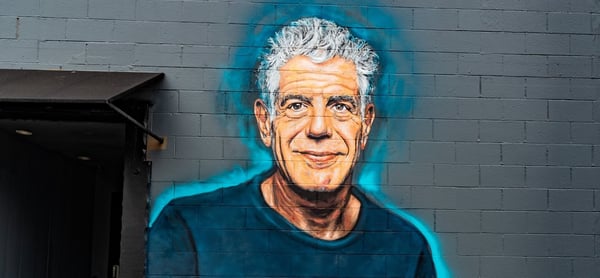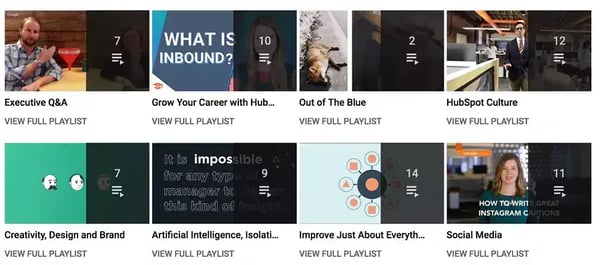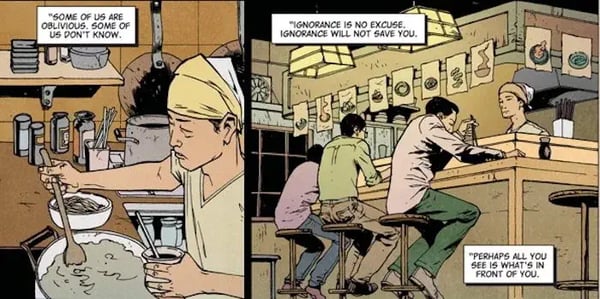If you’ve ever cracked open a travel guide or flipped through the cooking channel, you’ve heard of Anthony Bourdain. As “the rock star of the culinary world,” Bourdain was an engaging television personality, beloved for his authenticity. And of course, he was an incredible storyteller.
You see where this is going.
Since Bourdain passed, there’s been a ton of articles documenting his storytelling prowess. In hopes of copying and mastering his style, marketers have spun off articles like:
“What Anthony Bourdain Can Teach Us About Storytelling in 'Parts Unknown”
"What Anthony Bourdain Taught Me"
“Back to Our Storytelling Roots: Content Marketing Lessons We Can Learn From Anthony Bourdain’s Legacy”
As someone generating content for B2B, it’s easy to disregard these tips. Anthony Bourdain was a crude travel writer. He swore like a sailor and was pretty outspoken about his struggle with addiction.
However, despite being rough around the edges (which personally, I loved), Bourdain was exceptional at talking to people. Through his travel and food, Bourdain knew how to connect to people. And it was all thanks to one critical personality trait.
website grader
Diagnose Your Growth Blockers & Unlock Your Brand’s Potential
Enter your website URL and get a tailored marketing roadmap that reveals untapped opportunities to boost traffic, eliminate roadblocks, and fuel sustainable growth.
- Identify growth roadblocks on your website
- Pinpoint opportunities you can leverage to grow your brand
- Boost traffic with personalized strategies
Thanks for submitting the form!
6 B2B Storytelling Tips Inspired By Anthony Bourdain
Anthony Bourdain was a curious person, which made him so good at telling stories. He asked questions and dug into the details. He didn't shy away from conflict. His show "Parts Unknown" was literal. He went places, both physically and figuratively, that a lot of people wouldn't.
People loved his stuff because he wasn't overly promoting a place or trying to sell you a trip. He was just being honest. It's what his audience wanted.
Here at Lean Labs, we have a similar approach that focuses on bringing value and expertise to customers (which you can read more about here.) Our customer-centric process helps us create much more descriptive, engaging content.
Here are a few tips to get you started.
1. Master The Fine Details
One of my favorite writing tips is to write simply, but with specifics. Bourdain was a master at it. From vivid descriptions of "lechon” (roasted suckling pig) to a perfect summary of Waffle House, Bourdain knew how to add spice to words by thinking through the senses he felt while experiencing it.
Related: Anthony Bourdain describes Chicago to Anderson Cooper
While I don’t expect as a B2B, you’ll be writing much about food, you can still apply these tactics to different types of marketing content such as testimonials, lead nurturing emails, and blog content. From the beginning of any article outline or content strategy, explore your customer’s feelings and state of mind.
When I create content, I add more detail by asking, “How can I describe this better? What does the reader or viewer need to know about it?”
2. Brush Up On Your Short Stories
In "A Cook's Tour" and "Medium Raw," Bourdain uses short anecdotes, memories, opinions, and favorite places to tell one, big, cohesive story. In "A Cook's Tour," for example, each chapter is a different place. Each has a special flavor but contributes to the overall story.
In B2B, it reminds me of brands that set up a few YouTube playlists. HubSpot, for example, has a separate playlist for social media, new products, and HubSpot culture. Each video has a unique topic but serves that overarching subject. If you do it well, you can create a cohesive series that keeps viewers bingeing your stuff.
3. Unexpected Collaborations Add Color
"Hungry Ghosts," a graphic novel and cookbook, was one of Bourdain’s last projects, as well as was an unexpected collaboration. He worked with Joel Rose, an author, and graphic novelist to create the book of ghost stories, which comes with recipes.
The partnership was different from anything Bourdain ever did, leveraging Rose's talent as an author, and filmmaker to compliment Bourdain's cultural prowess with recipes of his food.
The collaboration also introduced each of their audiences to the other. People who loved Rose’s graphic novels got to know Bourdain, and people who loved Bourdain (like me), learned about Rose. In B2B, you can do the same thing by inviting unexpected collaborators to make a podcast, make an interview-style video, or co-author a guide.
4. Conflict And Controversy Are Key
From Beirut, Democratic Republic of Congo, Haiti, to Iran, Bourdain visited some dangerous places. Even when he was traveling in a safe place, he often shed light on the real conditions of a place, off the tourist track. And when he wasn’t traveling, he spoke out about his disdain for food trends like brunch and tasting menus, although he wasn’t in agreement with his audience or fellow chefs.
Related: Anthony Bourdain Rates Food Trends
Bourdain didn't hesitate to go against the grain, and he never shied away from conflict. He used those high-pressure situations to bring more tension to his stories.
Whether you’re shooting a video or writing an eBook, go beyond the surface and dig into the realities of your subject matter. Where’s the conflict in your topics? Personally, I like to address the likely frustrations that my reader or viewer is experiencing, which tells them that 1) They can trust me and 2) I understand them.
VIDEO TRAINING
Get The Growth Marketing Playbook.
Learn to plan, budget, and accelerate growth with our exclusive video series. You’ll discover:
- The 5 phases of profitable growth
- 12 core assets all high-growth companies have
- Difference between mediocre marketing and meteoric campaigns
Thanks for submitting the form!
5. Use Your Voice
Bourdain was so captivating because he was unapologetically himself. He shared a lot of personal detail in his writing. He was open about his complicated history and struggles. It's a skill that a lot of B2Bs are hesitant to pick up, due to being in a professional setting.
Related: Anthony Bourdain talks about life, death
While you don't want to go too dark in the business world, you can still use behind-the-scenes content and anecdotes to make a deeper connection with your audience. If you can show that there are real people working at your company, who experience the same day-to-day challenges as your customer, you can relate to your customer and make your material much more interesting.
6. Cut Down On Waste
Bourdain was exceptional at detail, but he never shared too much. The script for any standard “Parts Unknown” episode was minimal, with a few descriptive details and stories.
In his forty-minute episode about Huế, Vietnam, Bourdain explores World War II tunnels, visits an open-air market, and tries a few local dishes.
Related: Bourdain falls in love with Vietnam's street food
Since his stories were so lean and simple, when Bourdain did share a descriptive anecdote or a personal narrative, it shone. I find that a lot of B2Bs go overboard with content, with winded posts and long videos with a lot of unnecessary detail. Sometimes, it’s just more material than any potential customer needs.
I tend to go off on tangents when I write, so I’ve learned how to curb that by asking: what’s the minimum that my audience needs to learn from this? After I get the basics down, I go back and add more color to the outline or post, similar to sprinkling a little bit of parmesan cheese on a plate of pasta.
Engaging Authentically With Your Customers
I know that when it comes to creating more interesting content for a B2B, it’s easier said than done. Because if you’re already producing content and getting decent performance from those assets, there may not seem like there’s an incentive to make a change.
But in my experience, when growth is stagnant and your content is only okay, a little spice can make all the difference.








